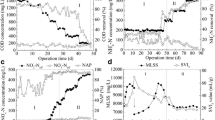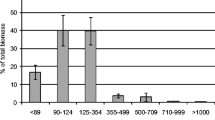Abstract
Granules were observed after more than two years of operation in two semi-continuously fed intermittently aerated reactors treating swine wastewater with aerobic:anoxic cycles of 1:1 h and 1:4 h. Subsequently, the granules and flocs were compared with respect to physical characteristics, activity, and microbial community structure. Granules exhibited higher specific nitrification and denitrification rates than flocs. However, once granule structural integrity was disrupted, the rates decreased to levels similar to those of flocs. Membrane hybridizations using 16S rRNA-targeted probes showed that ammonia oxidizing bacteria populations in flocs and granules were dominated by Nitrosomonas and Nitrosococcus mobilis. Granules provided better conditions for Nitrospira compared to flocs. The diversities of the dominant bacterial populations in granules and flocs were not significantly different. Our findings highlight the importance of structural integrity of granules to their nitrogen removing activity.





Similar content being viewed by others
Abbreviations
- X f :
-
VSS concentration in the IA reactor attributed to floccular biomass, mg VSS/L
- X g :
-
VSS concentration in the IA reactor attributed to granules, mg VSS/L
- X r :
-
VSS concentration in the IA reactor, mg VSS/L
- VSS:
-
Volatile suspended solids
- IA:
-
Intermittent aeration
- TSS:
-
Total suspended solids
- No :
-
Initial concentration of N in the reactor, mg N/L
- dN/dt g :
-
Change in N concentration over time due to granule activity, mg N/L*d
- dN/dt f :
-
Change in N concentration over time due to floccular biomass activity, mg/L*d
- VSS:
-
Volatile suspended solids, mg/L
- NH3–N:
-
Ammonia nitrogen, mg N/L
- NO3–N:
-
Nitrate nitrogen, mg N/L
References
Abe F (2007) Exploration of the effects of high hydrostatic pressure on microbial growth, physiology and survival: perspectives from piezophysiology. Biosci Biotechnol Biochem 10:2347–2357
Beun JJ, Heijnen JJ, van Loosdrecht MCM (2001) N-removal in a granular sludge sequencing batch airlift reactor. Biotechnol Bioeng 75:82–92
Biggs CA, Lant PA (2002) Modelling activated sludge flocculation using population balances. Powder Technol 124(3):201–211
Chen M, Lee D, Tay J (2007) Distribution of extracellular polymeric substances in aerobic granules. Appl Microbiol Biotechnol 73(6):1463–1469
de Kreuk MK, van Loosdrecht MCM (2004) Selection of slow growing organisms as a means for improving aerobic granular sludge stability. Wat Sci Technol 49:9–17
Dionisi HM, Layton AC, Harms G, Gregory IR, Robinson KG, Sayler GS (2002) Quantification of Nitrosomonas oligotropha-like ammonia-oxidizing bacteria and Nitrospira spp. from full-scale wastewater treatment plants by competitive PCR. Appl Environ Microbiol 68(1):245–253
Dytczak MA, Londry KL, Oleszkiewicz JA (2008) Nitrifying genera in activated sludge may influence nitrification rates. Wat Envron Res 80:388–396
Eaton AD, Clesceri LS, Rice EW, Greenberg AE (eds) (2005) Standard methods for the examination of water and wastewater. American Public Health Association, Baltimore
Fernandes PMB, Domitrovic T, Kao CM, Kurtenbach E (2004) Genomic expression pattern in Saccharomyces cerevisiae cells in response to high hydrostatic pressure. FEBS Lett 556:153–160
Gieseke A, Bjerrum L, Wagner M, Amann R (2003) Structure and activity of multiple nitrifying bacterial populations co-existing in a biofilm. Environ Microbiol 5(5):355–369
Haseborg E, Zamora TM, Fröhlich J, Frimmel FH (2010) Nitrifying microorganisms in fixed-bed biofilm reactors fed with different nitrite and ammonia concentrations. Biores Technol 101:1701–1706
Jang A, Yoon YH, Kim IS, Kim KS, Bishop PL (2003) Characterization and evaluation of aerobic granules in sequencing batch reactor. J Biotech 105:71–82
Juang Y-C, Adav SS, Lee D-J, Tay J-H (2010) Stable aerobic granules for continuous-flow reactors: precipitating calcium and iron salts in granular interiors. Biores Tech 101(21):8051–8057
Juretschko S, Timmermann G, Schmid M, Schleifer K-H, Pommerening-Röser A, Koops H-P, Wagner M (1998) Combined molecular and conventional analyses of nitrifying bacterium diversity in activated sludge: Nitrosococcus mobilis and Nitrospira-like bacteria as dominant populations. Appl Environ Microbiol 64(8):3042–3051
Lee D-J, Chen Y-Y, Show K-Y, Whiteley CG, Tay J-H (2010) Advances in aerobic granule formation and granule stability in the course of storage and reactor operation. Biotech Adv 28(6):919–934
Lemaire R, Webb RI, Yuan Z (2008) Micro-scale observations of the structure of aerobic microbial granules used for the treatment of nutrient-rich industrial wastewater. ISME J 2(5):528–541
Liao J, Lou I, de los Reyes FL (2004) Relationship of species-specific filament levels to filamentous bulking in activated sludge. Appl Environ Microbiol 70(4):2420–2428
Liu Y, Liu Q-S (2006) Causes and control of filamentous growth in aerobic granular sludge sequencing batch reactors. Biotech Adv 24(1):115–127
Liu Y, Tay J-H (2004) State of the art of biogranulation technology for wastewater treatment. Biotechnol Adv 22(7):533–563
Liu Y, Yang SF, Tay JH (2004) Improved stability of aerobic granules by selecting slow-growing nitrifying bacteria. J Biotech 108(2):161–169
Liu L, Li W-W, Sheng G-P, Liu Z-F, Zeng RJ, Liu J-X, Yu H-Q, Lee D-J (2010a) Microscale hydrodynamic analysis of aerobic granules in the mass transfer process. Environ Sci Tech 44(19):7555–7560
Liu Y-Q, Moy B, Kong Y-H, Tay J-H (2010b) Formation, physical characteristics and microbial community structure of aerobic granules in a pilot-scale sequencing batch reactor for real wastewater treatment. Enzyme Microb Tech 46(6):520–525
Mobarry BK, Wagner M, Urbain V, Rittmann BE, Stahl DA (1996) Phylogenetic probes for analyzing abundance and spatial organization of nitrifying bacteria. Appl Environ Microbiol 62:2156–2162
Molina-García AD (2002) The effect of hydrostatic pressure on biological systems. Biotechnol Genet Eng Rev 19(1):3–54
Morgenroth E, Sherden T, Van Loosdrecht MCM, Heijnen JJ, Wilderer PA (1997) Aerobic granular sludge in a sequencing batch reactor. Wat Res 31(12):3191–3194
Mota C, Ridenoure J, Cheng J, de los Reyes FL (2005a) High levels of nitrifying bacteria in intermittently aerated reactors treating high ammonia wastewater. FEMS Microbiol Ecol 54(3):391–400
Mota C, Head MA, Ridenoure JA, Cheng JJ, de los Reyes FL (2005b) Effects of aeration cycles on nitrifying bacterial populations and nitrogen removal in intermittently aerated reactors. Appl Environ Microbiol 71(12):8565–8572
Muyzer G, Hottentraeger S, Teske A, Wawer C, 1996. Denaturing gradient gel electrophoresis of PCR amplified 16S rDNA ¨A new molecular approach to analyze the genetic diversity of mixed microbial communities. In: Molecular microbial ecology manual. Kluwer Academic Publishers, the Netherlands, 3.4.4, 1-23
Picioreanu C, Xavier JB, van Loosdrecht MCM (2004) Advances in mathematical modeling of biofilm structure. Biofilms 1(04):337–349
Ross W (1984) The phenomenon of sludge pelletization in the anaerobic treatment of a maize processing plant. Water SA 10(4):197–204
Seviour T, Pijuan M, Nicholson T, Keller J, Yuan Z (2009) Gel-forming exopolysaccharides explain basic differences between structures of aerobic sludge granules and floccular sludges. Wat Res 43(18):4469–4478
Sokal RR, Rohlf FJ (1962) The comparison of dendrograms by objective methods. Taxon 11(2):33–40
Stahl DA, Flesher B, Mansfield HR, Montgomery L (1988) Use of phylogenetically based hybridization probes for studies of ruminal microbial ecology. Appl Environ Microbiol 54(5):1079–1084
Su K-Z, Yu H-Q (2005) Formation and characterization of aerobic granules in a sequencing batch reactor treating soybean-processing wastewater. Environ Sci Technol 39(8):2818–2827
Tay JH (2002) Specific layers in aerobically grown microbial granules. Lett Appl Microbiol 34:254–257
Tijhuis L, van Loosdrecht MCM, Heijnen JJ (1994) Formation and growth of heterotrophic aerobic biofilms on small suspended particles in airlift reactors. Biotech Bioeng 44:595–608
Williams JC, de los Reyes III FL (2006) Microbial community structure of activated sludge during aerobic granulation in an annular gap bioreactor. Wat Sci Tech. 54(1):139–146
Yilmaz G, Lemaire R, Keller J, Yuan Z (2008) Simultaneous nitrification, denitrification, and phosphorus removal from nutrient-rich industrial wastewater using granular sludge. Biotech Bioeng 100(3):529–541
Zheng Y-M, Yu H-Q (2007) Determination of the pore size distribution and porosity of aerobic granules using size-exclusion chromatography. Wat Res 41(1):39–46
Zheng Y-M, Yu H-Q, Liu S-J, Liu X-Z (2006) Formation and instability of aerobic granules under high organic loading conditions. Chemosphere 63(10):1791–1800
Acknowledgments
This research was funded by the US Department of Agriculture-National Research Initiative Program (Grant 2001-35102-10783). The authors acknowledge the contributions of Dr. Michael Dykstra from the NCSU College of Veterinary Medicine and to Dr. Nina Allen and Dr. Eva Johannes from the NCSU Department of Botany. The authors also thank Jennifer Ridenoure for her assistance in sample analysis.
Author information
Authors and Affiliations
Corresponding author
Rights and permissions
About this article
Cite this article
Mota, C.R., Head, M.A., Williams, J.C. et al. Structural integrity affects nitrogen removal activity of granules in semi-continuous reactors. Biodegradation 25, 923–934 (2014). https://doi.org/10.1007/s10532-014-9712-3
Received:
Accepted:
Published:
Issue Date:
DOI: https://doi.org/10.1007/s10532-014-9712-3




